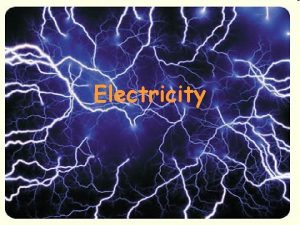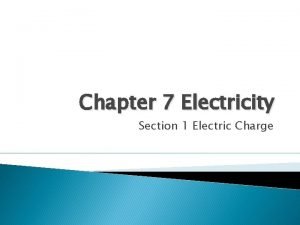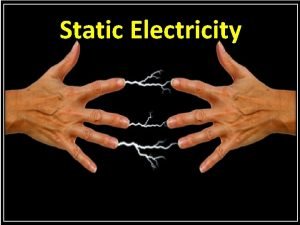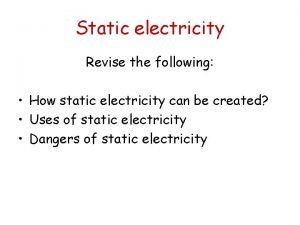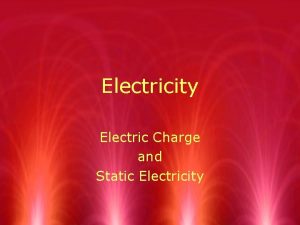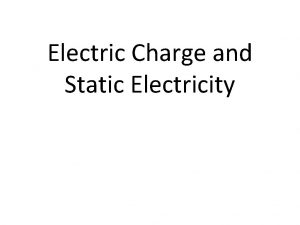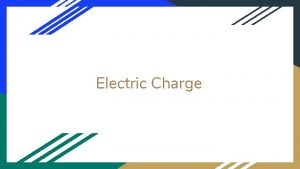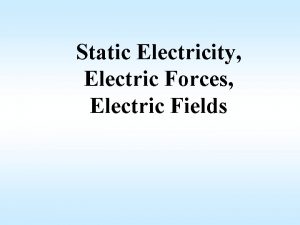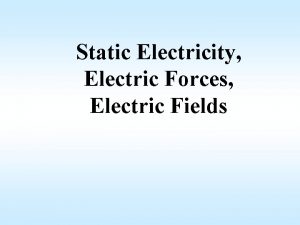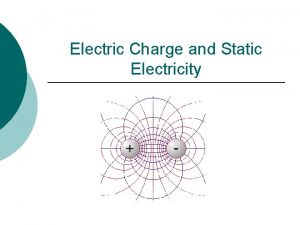Static Electricity Electric Charge Electrostaticsthe study of electric













- Slides: 13

Static Electricity

Electric Charge �Electrostatics—the study of electric charges that can be collected and held in one place �Shocked! �Balloons

Charged Objects �Two types of charges Positive Negative �Like charges repel �Opposite charges attract

A Microscopic View of Charge �Atoms contain electric charges Electrons (negative) Nucleus has a positive charge An atom is neutral when the positive charge of the nucleus is equal to the negative charge of the electrons. �Outer electrons can be removed from atoms with the addition of energy

Conservation of Electric Charge �As you rub your hair with a balloon some of your hair’s electrons are transferred to the ballo 0 n. �This gives your hair a positive charge and the balloon a negative charge. �The amount of negative charge lost by your hair is equal to the amount of negative charge gained by the balloon.

Conductors and Insulators �Insulator—a material through which a charge will not move easily Glass, dry wood, cloth, dry air �Conductor—a material that allows charges to move about easily Electrons carry electric charge though the metal Copper, aluminum

Charging Objects �Conduction—charging a neutral body by touching it with a charged body (rubbing hair with balloon) �Induction—charging an object without touching (balloon and wall) Polarization

Electroscope �You can find whether an object is positively or negatively charged by bringing a rod of known charge close to the knob

Grounding �The process of removing excess charge by touching an object to Earth �Earth can accept an unlimited number of electrons (Infinite reservoir for electrons) �A conductor that is connected to Earth is said to be grounded.

Forces on Charged Bodies �We know the following four statements are true: There are two kinds of electric charges: positive and negative Charges exert forces on other charges at a distance The force is stronger when the charges are closer together Like charges repel; opposite charges attract

Coulomb’s Law �A force acts between two or more charged objects Closer the charged objects are, the greater the force More charge in objects, great force Two charged objects near one another may experience acceleration either toward or away from each other because each object exerts a force on the other object.

Coulomb’s Law �SI standard unit of charge: coulomb (C) � 1 C = 6. 24 x 1018 electrons or protons � 1 electron has 1. 60 x 10 -19 C �K = 9. 0 x 109 Nm 2/C 2 �Electric force is a vector quantity, but Coulomb’s law only gives the force’s magnitude.

Sphere A, with a charge of +6. 0 μC, is located near another charged sphere, B. Sphere B has a charge of -3. 0 μC and is located 4. 0 cm to the right of A. a) What is the force of sphere B on sphere A? b) A third sphere, C, with a +1. 5 μC charge, is added to the configuration. If it is located 3. 0 cm directly beneath A, what is the new net force on sphere A?
 Static electricity and current electricity
Static electricity and current electricity Current electricity gif
Current electricity gif Electricity and magnetism vocabulary
Electricity and magnetism vocabulary Chapter 6 section 1 electric charge worksheet answers
Chapter 6 section 1 electric charge worksheet answers Electricity section 1 electric charge
Electricity section 1 electric charge Electricity section 1 electric charge
Electricity section 1 electric charge Difference between charge and electric charge
Difference between charge and electric charge Difference between static and current electricity
Difference between static and current electricity Chapter 21 electric charge and electric field
Chapter 21 electric charge and electric field Chapter 21 electric charge and electric field
Chapter 21 electric charge and electric field Units for coulombs
Units for coulombs Units of a charge
Units of a charge Static electricity
Static electricity How does a photocopier use static electricity
How does a photocopier use static electricity




